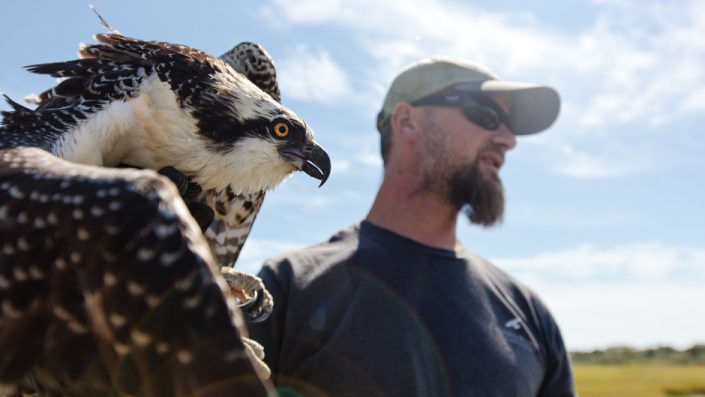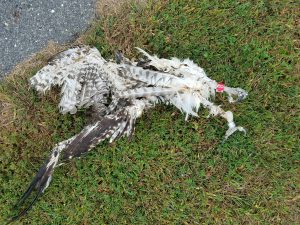The Fate of Chump: Osprey 78/D
Proof that life is never easy for young ospreys
by Ben Wurst, Habitat Program Manager

I thought long and hard about sharing this news, hence the delay in this post. In late October, we received news that a young osprey I banded this summer was re-sighted. It turns out that this bird was not your average young osprey, out of the 892 produced this year. This young bird hatched at a nest behind the Long Beach Island Foundation of the Arts & Sciences, around June 11th, a nest referred to as home to “LBI’s Most Famous Osprey Couple, Jack & Wendy.” He was banded, along with his nestlings, on July 5th. He was tagged with a red auxiliary “field readable” band: 78/D, as part of Project RedBand, which allows fellow biologists and citizen scientists the ability to identify the bird while still alive (most osprey band reports occur during mortality based events). At the time of banding, he was also given the name Chump, by Northside Jim.
A few weeks after being banded, a local resident reported a bird in distress (on the ground) at LBIF and I contacted Jim to see if he could respond. Long story short, he did and Chump was rehabbed within six weeks at Toms River Avian Care (on August 30th). After being released, we watched Chump make a strong flight around the marsh at LBIF until he flew off into the distance. We could only hope that he was strong enough to survive on his own, since he was too old for his parents to accept him back where he hatched.

On October 25th, we received a report that 78/D was re-sighted (his federal band was: 1088-14556) in Barnegat Light. Unfortunately, he was found dead on the shoulder of a road. I immediately emailed Casey Miller, who found and reported the band to USGS. I had hoped to investigate the body to try to determine the cause of death and retrieve the red band. My main reason for trying to determine the cause of death is to see if it could have been caused by a man-made object, like being hit by car, clipping a power line or electrocution. She emailed a couple photos of 78/D and said that the body was gone. So, it would be difficult to determine the exact cause of death using photos alone, but it did look like he didn’t die on 10/25 since his remains looked somewhat decomposed already. In addition, there was no tell tale signs of electrocution. Really hard to say what killed him. We can only speculate at this point.
We do know that young ospreys have very high mortality rates, upwards of 80% during their first year of life. The perils of living in a human dominated landscape, post-fledging, navigating to their wintering grounds for the first time (during hurricane season), and surviving in a landscape where some people see ospreys as competitors for food, are all very real threats to the survival of young ospreys to adulthood… Since 78/D was the runt of his nest, his chances of surviving were already low (ospreys exhibit asynchronous hatching (eggs hatch in the same order as they are laid), which is a natural adaptation that allows the oldest young to survive during times when food is scarce), and then he was found down on the ground (meaning he was NOT getting enough food to thrive, like his siblings). But, we did all that we could to help ensure his survival.
I don’t like to sugarcoat the truth, when we hear bad news about wildlife that we work hard to protect. By sharing this sad news, I hope to share a little truth of how life as a young osprey is never easy. Protecting all osprey nests during the nesting season is crucial to their long term sustainability in New Jersey. Even though we’ve documented over 600 young being produced each year over the past five years, only around 20% of those might survive to return to New Jersey to breed. The osprey population continues to grow at a slow pace, at around 10% per year. We have high hopes that with our conservation efforts, the osprey population will be stable for years to come. Rest in Peace, Chump!
Thanks to everyone who helped Chump: LBIF staff, members, and neighbors, Deb T., Northside Jim and family, Don Bonica/Toms River Avian Care, and the Sandpaper.
Full results from the 2017 Osprey Census will be published later this month.
Discover more from Conserve Wildlife Foundation of NJ
Subscribe to get the latest posts sent to your email.
Leave a Comment
Hi Ben, really so very sorry to hear about Chump. Thanks for your post. It must have been very difficult to write but please know that your efforts are greatly appreciated. Very sad for all of you who worked Chump. He looked like a magnificent creature.
Hey Lisa, Thanks. Yeah, it’s always sad to report news like this, but good to let people know the fate of this beloved bird.
That’s such a sad account, I’m so sorry to hear this news. RH
Ben, it was a treat to learn of New Jersey’s ospreys with you at the Pinelands Short Course a year ago. Heraldic birds, one wishes that every nestling could not only survive, but thrive.
Mary Wood and I have know for ages that our osprey population is blessed by your commitment, knowledge, enthusiasm and dedication.
As for not wanting to share the hard aspects of this saga, I, for one, welcome your honesty in this time of ‘fake news’ and concerted undermining of science.
Hold your truth banner high. THANK YOU profoundly, Ben, for nourishing ‘our’ ospreys, and informing their human neighbors of avian needs in our state, in our time.
Carolyn Foote Edelmann NJWILDBEAUTY Nature blog
Comments are closed.